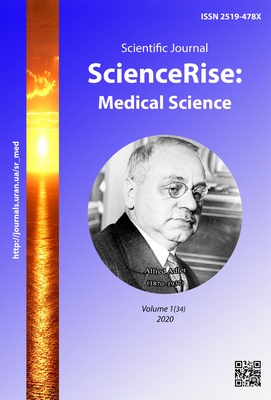Changes in parameters of hemodynamics in abdominal delivery with different methods of anesthesia
DOI:
https://doi.org/10.15587/2519-4798.2020.193841Keywords:
caesarean section, central and peripheral hemodynamics, general anesthesia, spinal anesthesia, hemodynamic types of circulation, risk, arterial hypotensionAbstract
Aim. To study and evaluate changes in the basic parameters of central and peripheral hemodynamics of the maternal organs in caesarean section (CS) with different methods of anesthesia.
Materials and methods. 127 pregnant women were divided into 4 subgroups: Ia (n=31) – general anesthesia (GA) using Ketamine, Ib (n=31) – GA with Sodium Thiopental, IIa (n=31) – spinal anesthesia (SA), IIb (n=34) – SA with Ondansetron 8 mg intravenous. The assessment was performed in 5 stages: 1 – initial; 2 – beginning of operation; 3 – fetal extraction; 4 – end of operation; 5 – 12 hours after operation. The main indicators of hemodynamics were analyzed: systolic (SAP), diastolic (DAP) and mean (MAP) arterial pressure, stroke volume of the heart (SV), cardiac output (CO), cardiac index (CI), total peripheral vascular resistance (TPR).
Results. Maximum increase of SAP, DAP, MAP, CI, CO in GA groups was found at the prenatal stage. Decrease of SAP, DAP, MAP in SA groups was indicated. Hypotension in IIa subgroup required correction with Mesatone in 23 women, while only five patients from IIb subgroup had a correction of hypotension with Mesatone.
Conclusion. In subgroups Ia and Ib, major hemodynamic changes were noted at the prenatal stage, which is manifested in energetically less favorable functioning of the cardiovascular system. CS with SA using Ondansetron was accompanied by favorable hemodynamic shifts at all the stages (especially at the prenatal stage), what is indicating "hemodynamic safety" of that method of anesthesia
References
- Mysovskaia, Iu. S. (2015). Dinamika pokazatelei operativnogo rodorazresheniia. Biulleten medicinskikh internet-konferencii, 5 (5), 436–437.
- Kulikov, A. V., Shifman, E. M. (2018). Anesteziia, intensivnaia terapiia i reanimaciia v akusherstve i ginekologii. Klinicheskie rekomendacii. Protokoly lecheniia. Moscow: Medicina, 824.
- Ghaffari, S., Dehghanpisheh, L., Tavakkoli, F. et. al. (2018). The effect of spinal versus general anesthesia on quality of life in women undergoing cesarean delivery on maternal request. Cureus, 10 (12), 371. doi: http://doi.org/10.7759/cureus.3715
- Mamovich, N. V., Kinzhalova, S. V., Makarov, R. A., Shakirov, R. T. (2019). Anesthetic management of abdominal delivery in females with multiple pregnancy. Messenger of Anesthesiology and Resuscitation, 16 (4), 24–30. doi: http://doi.org/10.21292/2078-5658-2019-16-4-24-30
- Khan, Z., Eftekhar, N., Barrak, R. (2019). General versus spinal anesthesia during caesarean section: a narrative review. Archives of Anesthesia and Critical Care, 5 (1), 18–21. doi: http://doi.org/10.18502/aacc.v5i1.743
- Nag, D. S., Samaddar, D. P., Chatterjee, A., Kumar, H., Dembla, A. (2015). Vasopressors in obstetric anesthesia: a current perspective. World Journal of Clinical Cases, 3, 58–64. doi: http://doi.org/10.12998/wjcc.v3.i1.58
- Chen, D., Qi, X., Huang, X., Xu, Y., Qiu, F., Yan, Y., Li, Y. (2018). Efficacy and Safety of Different Norepinephrine Regimens for Prevention of Spinal Hypotension in Cesarean Section: A Randomized Trial. BioMed Research International, 2018, 1–8. doi: http://doi.org/10.1155/2018/2708175
- Committee on practice bulletins – obstetrics. Practice bulletin No. 177: Obstetric analgesia and anesthesia (2017). Obstetrics and gynecology, 129 (4), 73–89. doi: http://doi.org/10.1097/aog.0000000000002018
- Honcharenko, M. S., Chykalo, T. M. (2011). Doslidzhennia adaptatsiinykh mozhlyvostei i fraktalnykh kharakterystyk kardioritma studentiv Kharkivskoho natsionalnoho universytetu imeni V. N. Karazina z riznymy typamy krovoobihu. Visnyk Kharkivskoho natsionalnoho universytetu imeni V.N.Karazina. Seriia: biolohiia, 13 (947), 170–175.
- Spicin, A. P., Kushkova, N. E., Kolodkina, E. V. (2018). Osobennosti centralnoi gemodinamiki u lic molodogo vozrasta v zavisimosti ot otlichii fakticheskoi chastoty serdechnykh sokraschenii. Zdorove naseleniia i sreda obitaniia, 7 (304), 27–30.
- Iupatov, E. Iu., Fatkullin, I. F. (2006). Znachenie issledovaniia gemodinamiki beremennykh dlia ocenki effektivnosti kompleksnoi terapii pozdnego gestoza. Kazanskii medicinskii zhurnal, 87 (4). 288–291.
- Dyer, R. A., Reed, A. R., van Dyk, D., Arcache, M. J., Hodges, O., Lombard, C. J. et. al. (2009). Hemodynamic Effects of Ephedrine, Phenylephrine, and the Coadministration of Phenylephrine with Oxytocin during Spinal Anesthesia for Elective Cesarean Delivery. Anesthesiology, 111 (4), 753–765. doi: http://doi.org/10.1097/aln.0b013e3181b437e0
Downloads
Published
How to Cite
Issue
Section
License
Copyright (c) 2020 Marine Georgiyants, Natalya Seredenko

This work is licensed under a Creative Commons Attribution 4.0 International License.
Our journal abides by the Creative Commons CC BY copyright rights and permissions for open access journals.
Authors, who are published in this journal, agree to the following conditions:
1. The authors reserve the right to authorship of the work and pass the first publication right of this work to the journal under the terms of a Creative Commons CC BY, which allows others to freely distribute the published research with the obligatory reference to the authors of the original work and the first publication of the work in this journal.
2. The authors have the right to conclude separate supplement agreements that relate to non-exclusive work distribution in the form in which it has been published by the journal (for example, to upload the work to the online storage of the journal or publish it as part of a monograph), provided that the reference to the first publication of the work in this journal is included.









